DIY Bark Tanning Leather Naturally.
C H E M I C A L // F R E E // T A N N I N G
Hey Steemit folks!
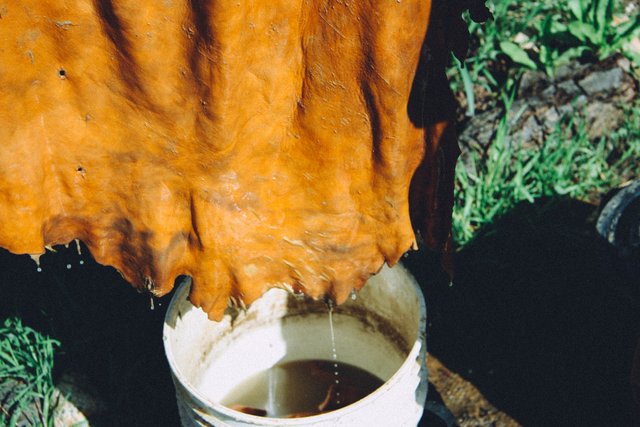

(tan oak acorns, one plant that can be used in bark tanning)
So this piece is on tanning animals skins, and I want to reiterate before you read further that my preference is using road kill skins in this process, animals that have been unfortunately harmed by cars. Preserving animals' skins in some form for clothing, protection, shelter has been a part of being a human engaging the land for a long time. It's not for everyone. This process is the 'ancient' natural one that doesn't use chemicals and is done with the upmost respect. I find it a spiritual process that engages the reality of the animal's death and my own inevitable mortality. Be aware that it can look, feel and smell (you can't smell it through the computer thankfully) gross.
I LOVE bark tanning. I love the intersection of plants with craft, and the idea that you can preserve an animal's skin seriously just with some tree bark or oak galls. It's pure magic. After going through the process many times, I am convinced the whole thing has some alchemical elements.
It is easier than you'd think.
What do I mean by bark tanning? We'll, all leather used to be made by soaking a skin in some form of tannin solution. Sometimes, it was in combination with urine, or some fats from whatever animals we're abundant in the region (this could be fish, or bear). This process has taken place all over the world and has been done by most people who have ever hunted and eaten animals, as long as humans have eaten animals. That's a long time. That's a lot of people.
Brain-tanning is another process I won't discuss here that requires a pretty different process, using animal brains, egg yolks or soap and oil to make buckskin or 'shammy' as my dad likes to call it.
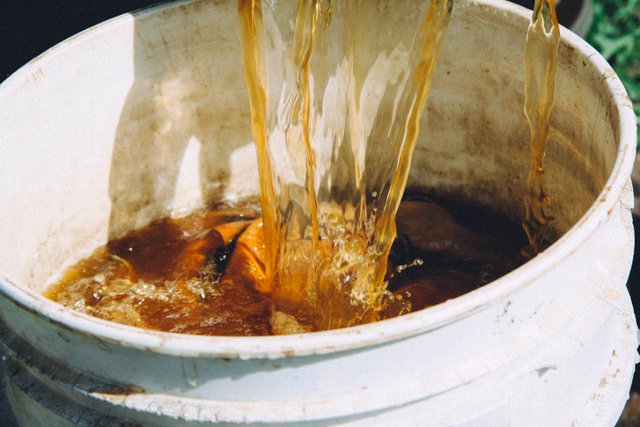
Another name for bark-tanned leather is 'vegetable tan' which you might see commercially sold but it is still not actually naturally tanned. It is very hard to do on an industrial scale economically. Most (95%) of commercial leathers are tanned with alum-todd or other chemicals to preserve and color the skin.
Even as soon as 75 years ago, many leathers were still bark-tanned. There was a tannery tradition in rural Europe that was the job of a specific group of people. They we're a lower 'class' usually, but made decent money in the trade, and often it was passed down generationally. Bark tanning smells. These tanneries smelled, and the people who did it probably smelled all the time. Tanneries on a small scale and in rural areas on family farms, where people did it seasonally, worked out well. Eventually the government started to impose strict regulations on folks tanning, only allowing people who have gone through extensive training to legally tan hides, and could only do it in the urban areas. Early leathers were made from deer in Europe, but eventually they were hunted out, and the leathers were switched over to domesticated animals. As the skill got transferred to more urban centers, the waters got polluted from the dumping of spent tannins (it takes a lot of water in general) and it stunk up the cities. The quality of the process downgraded too. Folks like Jim Croft- a medieval bookbinder I studied with last year in northern Idaho said that you can really see the change in leathers in old books- especially the really old ones.
The leather is especially inferior in present day commercially tanned leather with chemicals. It does not hold up in strength and age to bark tanned leather. But- not all bark tanned leather is super strong and amazing- it really does depend on what plants you use and how long you soak the hide in tannins for.
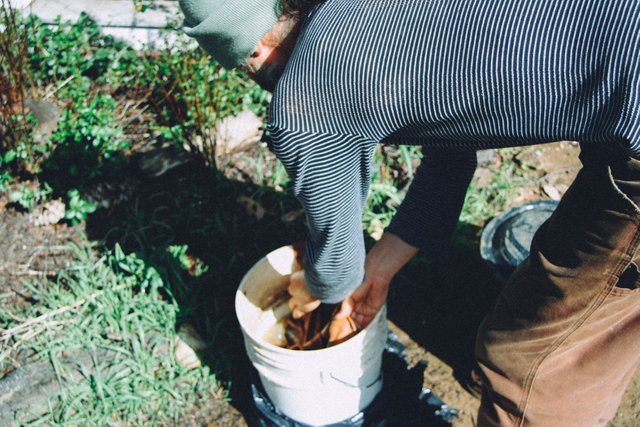
What you need:
an animal skin.
a deer skin, with hair removed (not scraped), or a small animal who you would want to tan with the hair on. Like, a road kill squirrel or rabbit. It's pretty difficult to bark tan hair on animal skins that have hollow hair, like deer.
buckets, or big totes.
you want a vat to hold a lot of liquid and for the animal skin to float around it with as much surface are exposed to the liquid as possible. Smaller animals require a lot smaller of a container.
a drawknife or pruners.
for harvesting plant matter for use in the process.
a piece of bamboo with the leaf joints pruned back smooth, the square edge of a piece of wood, or the back square side of a hide scraping planer blade.
this is for something called 'skudding,' which is a method of squeezing out the liquid in the hide to make room for more.
a scraping beam.
for slipping hair, or skudding.
tannic plant matter.
Usually this is the inner bark with the outer bark removed and shredded with a mallet. It could also be leaves (like with sumac for example) This depends on where you are. This could include any number of plants: Oak, Oak galls, Tan Oak, Hemlock, Douglas Fir, Sumac, Willow, Black Tea, Chestnut, Mimosa, Birch, Alder. There are different types of tannin that produce different kinds of leather, but I won't go into that detail here.
softening set up:
which could be as simply as using the end of your broom handle, or a braided metal cable tied to a tree, to soften the leather at the end. It's nice to string up a bark tanned hide on a frame to soften it, but I won't go into explaining that, here.
oil/fat/Tallow:
To coat the skin at the end. What you use depends on the leather you want. To keep it simple go with cheap vegetable oil your mom keeps in the back of the cabinet that hasn't been used in 5 years and shouldn't be eaten anyway.
wood Ashes / Lime / or Lye.
: I would suggest skipping the Lye and attempting to work with hardwood ashes if possible. Lye comes ultimately from wood ashes.
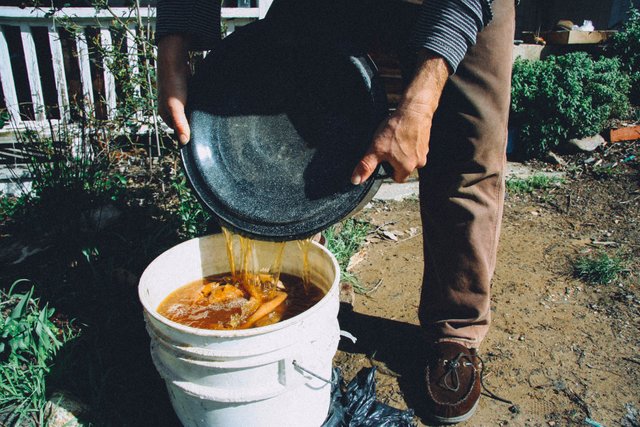
Step 1.
You want to 'buck' your hide. (Don't do this if you're doing a small animal that you're leaving the hair on, skip the next couple steps) Not everyone does this, but it will help the tannins penetrate the hide and tan quicker. Bucking is basically shifting the ph of the hide slightly alkaline which then makes the hair slip, and also breaks up mucous inside the hide. The alkalinity will make the hide slightly rubbery and slippery. I have over-bucked and destroyed hides before. That's easier to do with Lye, so I'd stick with wood ashes.
You'll want to leave the hide in the wood ash solution for a couple days. In the summer, it will go faster because of the heat. So check it after 24 hours. If the hide seems SUPER rubbery, or like it is starting to fall apart, it has gone to far. You want it to be slightly slippery to the touch, a LITTLE blue, and swollen. In cold weather, it will go slower, and it is safer. Pull the hide out after a couple days. Rinse some of the wood ashes off with fresh water, you can stick it in a running creek, or better in a vat of fresh water.
Step 2.
Dehairing. Throw the hide on a scraping beam. You can look up how to build one of these simple setups on braintan.com or Stephen Edholm's Youtube channel (he's the expert!). With the SQUARE side of a planer blade slip the hair off. Do NOT scrape the grain or the skin. You want to leave the grain, which is the epidermis and a little bit of the dermis of the skin, intact. This is different than what you do in brain-tanning, where you would want to scrape the grain off, which is incredibly labor intensive. Some of the hair will come off really easily. Some you'll need to just tug at and it will come out.
Step 3.
Neutralizing / Bating (again if you're leaving hair on, skip this step) You want to bring the ph of the hide back to neutral. The BEST way to do this, is to put the hide in a stream of running water for a day. (Some folks do something call bating, which is a combination of things like wheat paste, or urine, that pushes the ph back towards acidic, I've never done this) Important: put rocks on the hide and tie a corner of it to a tree, in case a rain comes, swells the creek, and wants to wash the hide away. This has happened. I have woke up in the middle of the night and went to the creek to make sure my hides were still there. The hide should start to have an astringent feel again after a day. move the rocks around in order to get an even ph balance all around. Careful on the grain- the outer epidermis side of the hide. You don't want to damage it. It's like the outside of your shoe- the layer of the leather than keeps things water proof. If it doesn't go all the way to neutral, as you change out tannins, it eventually will.
Step 4.
Harvesting tannin. You can scrape bark off of a fallen tree. This is great after a big storm, and the tree just fell, and you can take advantage of the tannin filled available bark. A tree that has sat there 6 months will have lost a lot of tannin to the weather. Take a drawknife and collect the bark, and use a tarp to hold it. I don't usually remove the outer outer bark, though some are meticulous about this. Some then pound out the bark to break it up more, which makes more tannins available, using a mallet and a chopping block. I do this sometimes. I have also heard of folks using a propane tank cut off, and a big hard piece of wood, and pounding bark in one of the metal drums to break it up. You can also harvest leaves, I often do this. I will cut the branches of Tan Oak, for example and break them up into a pot. Or, Sumac leaves can be cut and boiled in a pot. Acorns can be collected and boiled. Oak galls are extremely tannin and can be boiled. The tannins are more concentrated in the fall, or in dried plant matter.
Step 5.
Boil tannin. You'll want to throw a bunch of bark or leaves or oak galls in a pot of water (preferably not hard water) and boil for several hours. A lot of tannic brew is dark, but not all. Sumac can be a yellow or pink color, Alder a red color. Its fun to do this over a fire and do some incantations. Don't use cast iron for this. The iron can weaken the leather. Let it cool to at least lukewarm. Pour this strong liquid in a 5 gallon bucket, label as 1st boil, and boil the plant matter again. Take this liquid and pour it in a 5 gallon bucket, label as 2nd boil and then boil the plant matter a 3rd time. Take liquid and pour it into a 3rd bucket, label as 3rd batch as then toss the plant matter.
Step 6.
Combine hide and tannin. Use the bucket labeled 3rd boil first. You want to ease the hide into the tannins. There's a thing called case hardening where the hide may tan too fast on the outside and make it hard for the tannin to get to the middle. I've never had that happen, but others claim to have.
Step 7.
Move around daily. Skud every other day. You'll notice the hide starting to change colors. To take in the tannin. The tannin is basically pickling the hide, slowly. It is seeping into the fiber structure, and permanently altering it. This also slowly softens the hide. Bucking the hide opened up the spaces between the fiber layers and allows the tannin to penetrate more easily. Skudding is basically taking the hide out of the tannin bath, wringing it out GENTLY with your hands in the bucket, and then throwing the hide GRAIN down, on a THICK towel in order to not damage the grain layer. If you have a hard time telling which side is which, the membrane side usually has a lot of gunk peeling up and all over the surface, the grain layer is smooth and sometimes has pores. TO skud, you use your object of choice to gently abrade the membrane side of the hide. Sometimes I scrape on it a little but you have to be careful, and check the grain side to make sure you aren't messing it up. More skudding makes thinner and more flexible leather. Less, makes stiffer and thicker leather. This also helps make the hide a sponge that can receive more tannin.
Step 8.
Refresh tannins. When the water starts to clear, dump 1/2 of the water, and pour in bucket 2, the 2nd boil. You're easing the hide into stronger tannins this way. Do the same daily movement in order to get tannin on all the surface area, and do as much skudding as you can. You want to see the hide start to tan evenly. The color may be uneven at first. There more you move it around, the more even it will get.
Step 9.
Refresh tannins again. After a few days, the tannin will start to clear up again. Do the same thing as above and pour in bucket 3. Repeat moving and skudding.
Step 10.
Repeat plant matter boiling. Sometimes I do this process 10 or 20 times. A squirrel skin may only take a couple rounds of tannin. A deer could take 1 month to 6 months to a year depending on its thickness and your attentiveness. Its good to be really attentive at first, as to beat the rotting process. The smell should be more like musty black tea, not rotten putrid.
Step 11.
After many rounds of tannin baths, daily moving and skudding, check the progress of the tanning. Cut a sliver off the edge of the hide, preferably around the thickest part. If it is colored all the way through, it is done. If it isn't, then keep going.
Step 12.
Oiling. After you've decided to be done, you can oil the hide. With hair on hides, you'll just do the membrane side. With hair-off hides, you'll want to oil both sides. This keeps the grain from cracking. Just like oiling your leather shoes. Sometimes I put my hides in brains at this stage and do one round of brain softening but I won't go into that method here. So, take your hide out of the bath, say a prayer, skud the hide one last time to get out extra moisture and let it dry just a tad. The massage oil into both sides of the hide.
Step 13.
Softening. You'll want to keep the hide moving until it dries. You might want to oil it several times, if it looks like it needs it. This is where I use the cable. But ONLY on the membrane side. You can mess up the grain side if you cable on that side. This helps to soften and integrate the oils. I recommend to keep the hide moving until it is fully dry, it can stiffen up. This is pretty hard work, so pick a day that you have many hours to work the hide until it dries. I will sometimes sit on a stool with a broom and use the broom handle pressing into the hide to break it up, especially thicker areas like the neck and hips.
You're done!
You could trim the edges, and admire you natural leather. It will look SO MUCH BETTER than commercially tanned leather, feel good in your hands. At this point, the combination of the tannins and the oils have preserved the animals skin, and if tanned long enough, it will not rot. Keep it oiled, and it will be decently waterproof.
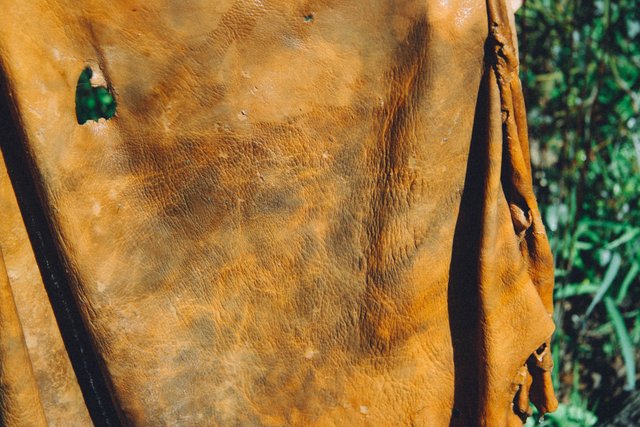
(finished leather)
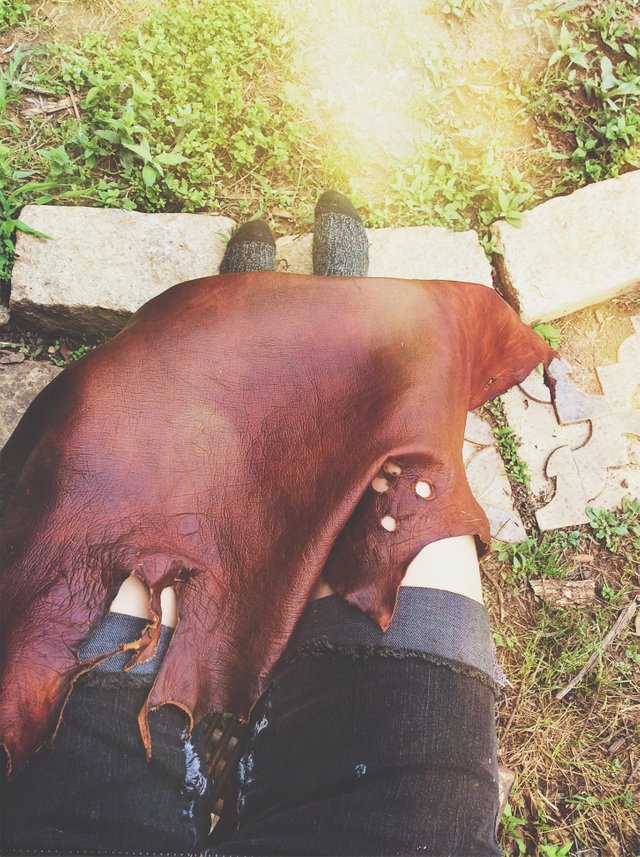
Congratulations, your post has been selected to be included in my weekly Sustainability Curation Digest for the Minnow Support Project.
Host of The Alternative Lifestyle Show on MSP Waves Radio.
Editor of the Weekly Schedule of Steem Radio Shows.
Founder of the A Dollar A Day charitable giving project.
thank you!! I appreciate it. I hope folks learn lots!
wow, thank you for this and beautiful. i have tried to do the "brain tanning"-used eggs once and brains another time) in late winter and it just never finished while i was doing the rubbing fast enough and i lost hope. i have a couple goat hides (that we had on our land) in the freezer (put in immediately with hair on) and two deer hides (one a roadkill and one ini shot for our sustenance) that are partially scraped, but are hard obviously. will i face any issues starting this process up again with the hardened ones? by this point they've been sitting out for months and the flies have done their word - they don't smell, they're just crispy.
i was getting really excited reading this as i have not researched tanning in this way before, but then i saw 6 months-1 yr for deer hides! wow that is quite an investment of time.
so i wanted to ask- you have you 1,2,3 buckets of the tannic solution and the hide is in the bucket, you're moving it around each day... about how long does it take for the tannic solution to go to clear?
scudding is basically rubbing it a bit with an object that isn't rough on the edge- or you do want it a little rough to rough up (especially the membrane side but be more careful with the pore side?) and then twist and get the water out and then put it back in the tannic solution? you do this for at least a month for the deer hide (i read the part about checking it to see if it's gone all the way through, just trying to get a ball park.)?
what solution did you use for that last image? that reddish color is amazing!!
i am very curious what colors the sumac make- we have a lot of that around here- as well as the mimosa. i'm sure this is another nuanced world unto itself... all of the varying natural colors that can be made. so so cool. i looked up Steven Edholm as you suggested.
i've been wanting to dive further into this for so long so THANK YOU THANK YOU. resteemed for visibility and so i can easily come back to it! <3
a lot to answer and a lot of try to explain without being there in person to show you. and I've taught classes on this before, but not lately since being on the road.
so braintanning- totally different than this, and don't lose hope. At least when it comes to softening you almost have to do it MANY times to get it soft. that means putting it back in the brains over and over. many folks don't tan them all in one go either, they'll dry them and get back at it later. you can pick those hides up and throw them in brains and go again. but there could be other things going on - not scraped enough membrane or grain off, too alkaline (if you bucked it), or other things.
freezer hides- they are good in there for quite awhile. the hair will likely slip but that's okay. i even use a freezer to soften! it breaks up the fibers. folks do that in northern climates in winter to soften hides- leave out in the snow and bring in and put in brains again.
tannin solution- it will go fast at first. in a day or two. i usually have several boils around in buckets and just dump half of the 'spent' tannin out and replinish with concentrated stuff often. it will keep going clear. i literally do this like 20 times or more to get it really tanned. a fish skin would take hardly no time.
skudding- it would either be a blade like what you use with brain tan-wet scrape method- or a piece of bamboo or broom handle, the round side. i tend to scrape hard on mine, constantly checking that i didn't damage the surface of the leather or the grain on the other side, but i also prefer that softer thin leather. some folks just skud gently by basically wringing it out. its like a sponge that needs to be squeezed in order to let more liquid in, so that the new tannin liquid can penetrate and the tannins will bind permanently to the fibers, also kind of breaking it down in a good way. (there's so much science to this)
braintan.com has tools and stuff.
last picture solution- tan oak!
sumac makes a pinkish color. it is also more concentrated in the fall when the leaves start to turn red. you could use any oak bark, branches, galls, willow, coffee and black tea! dry some sumac now in the barn, and when it is dry it is more tannic. make a fire and boil some in a pot you will use just for this. let it go a couple hours. when it cools down to where you can put your finger in it, pour it in a bigger tub than this bucket above- that is better for it to move around. and then just stick a scraped hide in there. you can do hybrid braintan/barktan too. like do it half one way and half another. experiment! and also get books- that are helpful.
it doesn't have to take 6 months either- it just did for me because of traveling. it goes faster in summer!
Very nice article and very detailed. I have tons of hides in the freezer to tan and no shortage of acorns. Upvoted and Resteemed.
do you hunt? I have had hunters give me dozens of hides before from processing deer. it actually can be quite overwhelming.. and exciting.
Not much, I breed meat rabbits and other livestock I would be using the hides from.
Great article I will be trying this very soon on rabbit and goat mainly but maybe I'll try it on hog or cattle also just to see since I will have them anyways.
rabbit will be the easiest and very quick- except they can tear easily if you're not careful!
goat and cattle will be tougher and longer.. you just keep changing out the tannins and if you have a farm you can just leave the vat by the barn and stir it occasionally. it shouldn't smell much (besides fermented black tea) after a few weeks and if the tannin gets replenished quickly. good luck!
Thanks I was thinking of looking for a hot tub that holds water with a cover for larger hides to soak.
I decided to feature this article in my resteem challenge as 1st place for the day. You will get 50% of SBD from the article after payout.
https://steemit.com/resteem/@ahabresteems/ahad-resteems-resteem-contest-winners